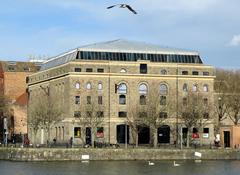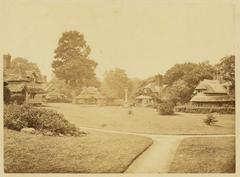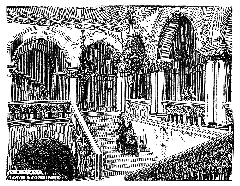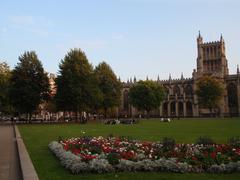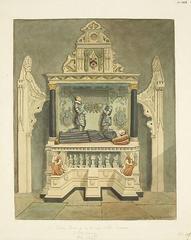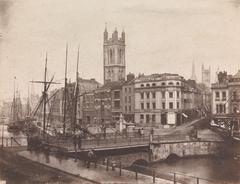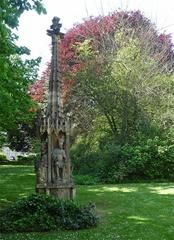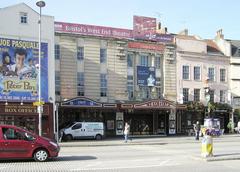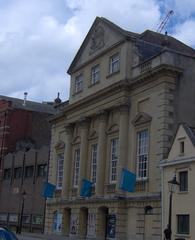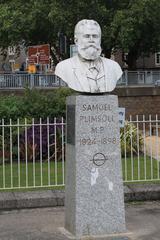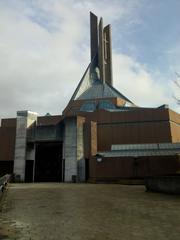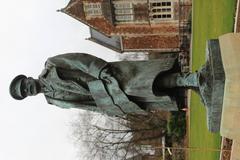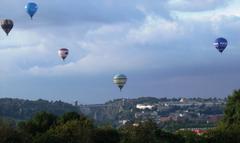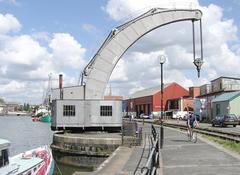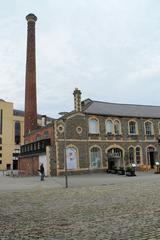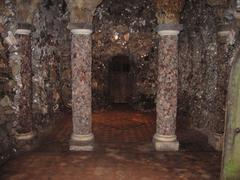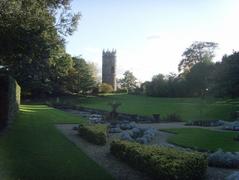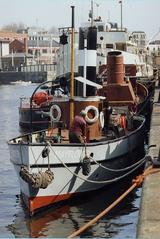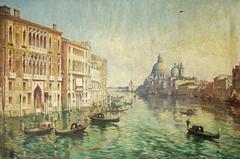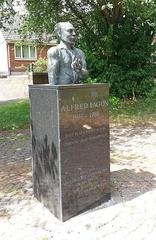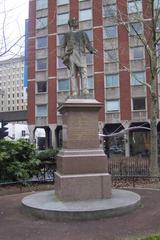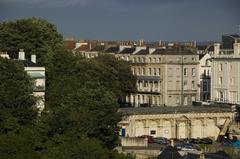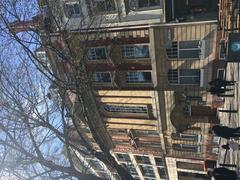
Durdham Down: Visiting Hours, Tickets, and Historical Sites in Bristol – An In-Depth Guide
Date: 04/07/2025
Introduction: Durdham Down’s Place in Bristol’s Heritage
Durdham Down, situated on the northwestern edge of Bristol, is one of the city’s most valued green spaces. Together with Clifton Down, it forms “The Downs,” an iconic 400-acre expanse known for its historical depth, scenic vistas over the Avon Gorge, and enduring role as a recreational and cultural heart for Bristol’s residents. Its landscape blends ancient heritage with contemporary community life, making it an essential destination for visitors seeking a connection to Bristol’s past and present (Wikipedia: The Downs, Bristol).
Historical Overview: From Anglo-Saxon Charter to Protected Urban Oasis
Early Origins and Medieval Use
The documented history of Durdham Down stretches back to an Anglo-Saxon charter of 883 AD, which established grazing rights and boundaries still marked today by seven historic Merestones. Throughout the Middle Ages, the Down served as common pastureland for the manor of Henbury, valued for grazing sheep and shaped by long-standing natural features like ancient yew trees (Local Learning: Downs History Report).
Civil War and Early Modern Significance
During the English Civil War, Durdham Down’s open fields became strategic assembly grounds for both Royalist and Parliamentarian armies. Though archaeological evidence is sparse, historical records confirm its military significance (Wikipedia: Durdham Down).
19th Century: Preservation Amidst Urban Growth
As Bristol expanded in the Victorian era, concerns about losing the Downs to development led to decisive action. The Bristol Corporation acquired commoners’ rights and, in 1861, the Clifton and Durdham Downs (Bristol) Act was enacted. This legislation preserved the area “for ever hereafter open and unenclosed,” securing it as public space through the formation of the Downs Committee—a joint body of city councillors and the Society of Merchant Venturers (Merchant Venturers).
Grazing Traditions and Changing Land Use
Sheep grazing shaped the Downs’ landscape for centuries, with ceremonial grazing still taking place every five years to honor the land’s historic rights and legal protections. This unique tradition links Bristol’s modern identity to its pastoral roots (University of Bristol News).
The Downs as a Social and Recreational Hub
By the late 19th and early 20th centuries, Durdham Down had evolved into a key recreational area. The introduction of tram services and the hosting of large-scale public events—such as the Royal Agricultural Show and Queen Victoria’s Golden Jubilee—cemented its role as a space for communal gatherings, sports, and celebrations (Merchant Venturers).
Conservation, Community, and Cultural Value
Environmental Stewardship
Since the 1861 Act, the Downs Committee has managed the area as a sanctuary for both recreation and conservation. Designated as a Site of Nature Conservation Interest, Durdham Down supports rare grassland species and serves as an outdoor classroom through initiatives like the Avon Gorge & Downs Wildlife Project (Bristol City Council, Avon Gorge & Downs Wildlife Project).
Community Engagement
Local groups, such as the Friends of the Downs and Avon Gorge, play a vital role in community activities and stewardship. The Downs’ management reflects a collaborative approach that balances heritage, ecology, and public enjoyment (Merchant Venturers: The Downs at the Heart of Our Community).
Notable Features
Landmarks include the 1954 concrete Water Tower near Blackboy Hill, the commemorative blue plaque for Victoria Hughes, and avenues of horse-chestnut and hawthorn trees. The area is also home to scheduled ancient monuments such as the Roman Road and Clifton Down Camp (Wikipedia: Durdham Down).
Practical Visitor Guide: Hours, Tickets, Accessibility, and Travel Tips
Visiting Hours and Entry
- Opening Hours: Open 24 hours a day, year-round, for unfettered public access (Day Out With The Kids).
- Entry Fee: Free for all visitors; no tickets required except for special events (Funderworld, Feast On).
Getting There
- Bus: Frequent city buses (routes 1, 2, 3, 4) serve the Downs (Funderworld).
- Train: Clifton Down station is a 15-minute walk away.
- Car: No permanent public car park; parking is limited to surrounding streets. Temporary parking is available during large events (Day Out With The Kids).
- Cycling/Walking: Numerous paths and cycleways connect the Downs to nearby neighborhoods.
Accessibility
- Largely flat terrain and paved paths make the Downs accessible for wheelchairs and pushchairs (Day Out With The Kids).
- Public toilets, including baby changing facilities, are available and accessible.
- Assistance and guide dogs are welcome (Funderworld).
Facilities
- Cafe Retreat: Offers homemade food and drinks.
- Food Stalls: Present during events such as Funderworld and Feast On (Funderworld).
- Picnics: Popular on the open lawns; check event restrictions for large group picnics.
Visitor Tips
- Dress for the weather and bring sun protection.
- Wear comfortable footwear for walking.
- Arrive early during weekends or events for the best spots.
- Use bins or take litter home to help preserve the space.
Attractions and Activities
Outdoor Recreation
- Expansive lawns for walking, jogging, football, cycling, kite flying, and informal play.
- Designated areas for horse riding and sports pitches.
Cultural and Historic Landmarks
- Nearby Clifton Observatory and Clifton Suspension Bridge offer iconic views and historic interest (Day Out With The Kids).
- Remnants of an Iron Age hillfort and a Roman road are located within the Downs.
Wildlife and Nature
- Known for wildflower meadows and rich biodiversity; discovery walks and wildlife talks are held regularly (Avon Gorge & Downs Wildlife Project).
Annual Events and Festivals
- Funderworld Theme Park: The UK’s largest mobile theme park (April–May 2025) (Funderworld).
- Feast On Food Festival: July 24–27, 2025, celebrating Bristol’s food scene (Feast On).
- Wildlife Discovery Sessions: Scheduled throughout the year (Avon Gorge & Downs Wildlife Project).
- Traditional Sheep Grazing: Every five years, connecting the present to centuries-old customs (University of Bristol News, Bristol Post).
Social and Community Dynamics
Durdham Down continues to reflect and respond to Bristol’s evolving social landscape. Issues such as the presence of caravans and mobile homes on its periphery highlight ongoing housing challenges and community responses, shaping the character of the space and public discourse.
Seasonal and Photographic Highlights
- Spring: Wildflower blooms and fresh greenery.
- Summer: Peak event season and outdoor activities.
- Autumn: Vibrant foliage and quieter paths.
- Winter: Tranquil, open landscapes—occasionally dusted with snow.
Photographers will find excellent vantage points, especially at sunrise or sunset, with panoramic views over the Avon Gorge and Clifton Suspension Bridge.
Frequently Asked Questions (FAQs)
Q: What are the opening hours?
A: Durdham Down is open 24/7 year-round.
Q: Is there an entry fee?
A: No; general access is free. Special events may require tickets.
Q: Are dogs allowed?
A: Yes, but they must be kept under control and cleaned up after.
Q: Are there public toilets and baby changing?
A: Yes, accessible facilities are available.
Q: How do I get there by public transport?
A: Multiple bus routes and Clifton Down train station provide easy access.
Q: Is there parking?
A: No dedicated public car park, but temporary parking may be arranged for major events.
Essential Resources for Visitors
- Funderworld Theme Park
- Feast On Food Festival
- Avon Gorge & Downs Wildlife Project
- Friends of the Downs
- Bristol City Parks Guide
- Historic Sites in Bristol
- Family-Friendly Activities in Bristol
Unique Features
- The ceremonial sheep grazing, a living tradition since the 1861 Act.
- Ancient boundary stones, scheduled monuments, and sweeping Victorian avenues.
- Lively calendar of community events and wildlife education programs.
Summary: Key Visiting Tips and Recommendations
Durdham Down exemplifies Bristol’s commitment to balancing natural heritage and urban development. Its history, legal protection, and ongoing stewardship ensure it remains a welcoming, democratic space for nearly half a million annual visitors. Whether you seek tranquility, cultural celebration, or educational enrichment, Durdham Down invites you to experience its vibrant legacy and enduring beauty (University of Bristol News, Merchant Venturers, Bristol City Council, Visit Bristol).
References
- Wikipedia: The Downs, Bristol
- Downs History Final Report, Local Learning
- How the Downs Came to Be, Merchant Venturers
- Sheep Grazing Tradition, University of Bristol News
- The Downs, Bristol, Bristol City Council
- The Downs at the Heart of Our Community, Merchant Venturers
- Avon Gorge & Downs Wildlife Project
- Visit Bristol: The Downs
- Day Out With The Kids: Clifton & Durdham Downs
- Funderworld
- Feast On Food Festival
- Bristol Post: Sheep return to the Downs
- All Events in Bristol: The Downs
- Friends of the Downs
For the latest news, updates, and event listings, download the Audiala app and follow us on social media. Start planning your visit to Durdham Down and experience the best of Bristol’s heritage, nature, and community life.

